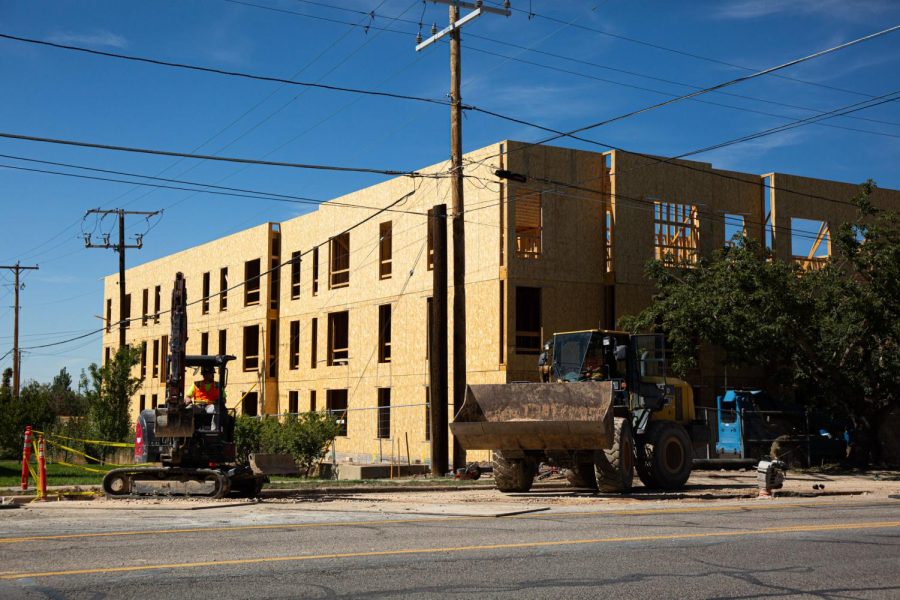Utah Legislature Approves $55 Million for Affordable Housing
Richmond Flats Project at 2960 S. Richmond Street, in Salt Lake City, Utah on Sept. 27, 2022. (Photo by Julia Chuang | The Daily Utah Chronicle)
September 30, 2022
The Utah legislature recently approved $55 million to be spent on the construction of over 1,000 affordable housing units throughout Utah.
Over $30 million of this grant will be spent on affordable housing projects in Salt Lake, with a large portion of this money being spent on phase two of Pamela’s Place, The Point Fairpark Project and the Tiny Home Village Project.
This approval for affordable housing comes as housing prices continue to rise, with the median price of a single-family home in Salt Lake County reaching $625,000 this past summer, almost 20% higher than the summer of 2021. That same median price was $300,000 just six years ago.
Making Housing Affordable
Sarah Canham, associate professor of City and Metropolitan Planning and of Social Work at the University of Utah, said that affordable housing has become a necessity in many communities, with government action needed to be taken to start to solve this problem.
“We have a shortage of affordable housing and a significant need for affordable housing in the community,” Canham said. “It’s not being answered by the private market and so there’s a need for it to come from different levels of government.”
According to Erin Carraher, associate professor and director of undergraduate studies for the School of Architecture at the U, this affordable housing investment is especially important for students who are unable to secure housing at the U and don’t qualify for government subsidies.
“I don’t know about you, but I don’t know any students that make $100,000 a year,” Carraher said. “They’re likely not able to afford the kind of standard housing that’s out there these days.”
Many of the housing projects that will be constructed because of this affordable housing grant approval will be within a 10 to 20 minute drive of the U.
At the U, President Randall has indicated plans to create several thousand new housing units on campus in the coming years to support students who can’t find or afford off-campus housing, said Carraher, with two currently underway.
“The only two projects currently under construction are the Family and Graduate Student Housing replacement project and the upcoming Sorenson Impact and Prosperity Epicenter, which is projected to open in late 2024,” Carraher said.
According to Carraher, several people in the School of Architecture are also currently working on generating solutions for those who need affordable housing.
“There are researchers and practitioners in my college working on actionable, replicable models for how to solve the affordable housing issue by partnering with local nonprofits and private industry,” Carraher said.
The Benefits
According to Canham, this affordable housing project will essentially keep people from moving out of Salt Lake to look for more affordable areas.
“When we have a variety of different housing types for different income levels, it then allows people to have more choice over where they live so people don’t have to move further out of the city or further away from campus,” Canham said. “ They’ll be able to afford to … live in the communities where they’re going to go to school or where they’re going to work.”
This affordable housing will be able to help the economy and the city in the long run, said Canham, with more people being able to contribute economically because of a lower housing cost.
“The more that we can keep people living in the city, the more that they will be contributing to the tax base within the city and the more they’ll be purchasing at our grocery stores and the other stores in our communities,” Canham said. “That tax base is really important for our roads and for our services and for ensuring that the communities that we live in are thriving.”
According to Canham, with people of multiple different income levels living together, Salt Lake won’t be as segregated by income and will become more willing to provide to those who can’t afford regular housing.
“There’s been pushback against homeless resource centers and homeless shelters being built in certain places in our city,” Canham said. “The more we can incorporate spaces for people with multiple income types, then the more it will become accepted.”
With innovation, said Carraher, this housing problem won’t turn into a long term crisis and those who are making lower income won’t be pushed out of the city by housing prices.
“Why is it important that Utah invests in affordable housing?” Carraher said. “Because we can’t afford not to.”









